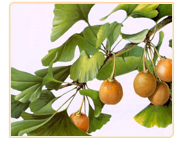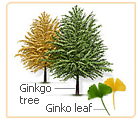What is Ginkgo Biloba?
Ginkgo biloba is a plant that has been used in traditional Chinese medicine for thousands of years. Today, it is a popular herbal medication in both the US and Europe, and it can be used to treat a variety of health conditions. Taken on a regular basis, Ginkgo biloba can improve circulation, mood, and mental performance. The medicinal properties of Ginkgo are located in its leaves and seeds.
Background and History of Ginkgo biloba
The Ginkgo biloba tree is native to China and is one of the oldest living tree species in the world, dating back over 200 million years. The Chinese have long believed that Ginkgo is beneficial in treating circulatory disorders and ailments such as asthma and stress. Seeds from the Ginkgo biloba plant, as well as its leaves, have been used in Chinese herbal medicine for centuries.
 The Ginkgo tree is mainly cultivated in China, but can also be found in other Southeast Asian countries, Europe, and the US. Ginkgo biloba trees are famous for their medicinal benefits but are also popular ornamental trees, and can still be seen lining the streets of Manhattan. The Ginkgo tree is mainly cultivated in China, but can also be found in other Southeast Asian countries, Europe, and the US. Ginkgo biloba trees are famous for their medicinal benefits but are also popular ornamental trees, and can still be seen lining the streets of Manhattan.
Ginkgo biloba Etymology (Name Origins)
 The name Ginkgo comes from the Chinese word y�nx�ng meaning "silver apricot." The scientific name Ginkgo seems to be the result of a misspelling. It�s believed that when the Ginkgo tree was introduced to Japan from China the Japanese pronounced it Ginnan. However, because Chinese characters have various pronunciations in Japanese, Ginnan could also be pronounced Ginky. The name Ginkgo comes from the Chinese word y�nx�ng meaning "silver apricot." The scientific name Ginkgo seems to be the result of a misspelling. It�s believed that when the Ginkgo tree was introduced to Japan from China the Japanese pronounced it Ginnan. However, because Chinese characters have various pronunciations in Japanese, Ginnan could also be pronounced Ginky.
When the Ginkgo tree was later introduced to Europe by Engelbert Kaempfer, his writing was apparently misread and so the y became g. This spelling has been used ever since. Ginkgo has numerous names and synonyms, which are explained in more detail below.
Fast fact: The only living survivors of the Hiroshima bomb blast in Japan were several Ginkgo biloba trees.
Different Names of Ginkgo biloba (Synonyms)
Ginkgo has many different names because of its Asian origins and the changes its name has undergone. The name you use will often depend on which country you live in. The most common names are:
 . Ginkgo . Ginkgo
. Japanese silver apricot
. Maidenhair tree
. Kew tree
. Yin Guo Ye Wan
. Bai Guo Ye
. Yin Xing Tong Ye
. Yinhsing (yin-hsing)
Ginkgo is often referred to as Ginkgo biloba L., the L standing for Linnaeus, the botanist who named the plant. Ginkgo biloba is also commonly misspelled as Ginko biloba, Gingo biloba or Ginkgo bilova. Read on to find out how the Ginkgo biloba tree grows.
How Does Ginkgo biloba Grow?
 The Ginkgo tree grows best in moist, temperate climates. It is adaptable to many different types of soil but sandy, well-drained conditions are favorable. The Ginkgo tree is extremely resistant to pollution, pests, and disease, and this explains its popularity as an ornamental street tree. Each tree can grow up to 120 feet tall and live for as long as 1000 years. The Ginkgo tree grows best in moist, temperate climates. It is adaptable to many different types of soil but sandy, well-drained conditions are favorable. The Ginkgo tree is extremely resistant to pollution, pests, and disease, and this explains its popularity as an ornamental street tree. Each tree can grow up to 120 feet tall and live for as long as 1000 years.
The Ginkgo biloba plant belongs to the ginkgoaceae plant family in which plants are famous for their short branches and inedible, potent fruits. Because it is a deciduous plant, the Ginkgo biloba tree sheds its leaves and fruits during the fall. The next section will show a more detailed description of how the Ginkgo biloba looks.
What Does Ginkgo biloba Look Like?
 The Ginkgo biloba tree is very tall and slender but it becomes broader with age. It is usually green or yellow in color with a bark that is reddish brown. Ginkgo leaves are extremely unique; they are fan-shaped and have parallel veins running through them. The Ginkgo leaf is often compared to a duck�s foot because of its unusual shape. The Ginkgo biloba tree is very tall and slender but it becomes broader with age. It is usually green or yellow in color with a bark that is reddish brown. Ginkgo leaves are extremely unique; they are fan-shaped and have parallel veins running through them. The Ginkgo leaf is often compared to a duck�s foot because of its unusual shape.
Only the female Ginkgo plant grows fruit but this does not happen until the plant is about 20 years old. The fruit produced (often referred to as a seed) looks similar to a plum - oval-shaped, up to 1 inch in diameter and slimy - except it is orange in color. Once the smelly pulp is removed the fruit is washed and sun-dried. Male Ginkgo biloba trees can be distinguished by their small pollen cones.
Now that Ginkgo biloba has been explained in detailed. Click the following link to read the next section to better understand how Ginkgo biloba works.
Conclusions About Ginkgo biloba
The Ginkgo biloba herb is helpful in relieving some symptoms of menopause, such as circulatory ailments. Because Ginkgo contains phytoestrogens, plant chemicals which act in a similar way to estrogen, it raises hormone levels by replacing human hormones with plant substitutes.
However, many health experts believe that non-estrogenic herbs are safer because they encourage the body�s own production of hormones and do not introduce external hormones into the body and do not have the side effects associated with Ginkgo biloba and other phytoestrogenic herbs.
Which herb should women try? Today women are looking for relief from their menopause symptoms with herbs. Phytoestrogenic herbs and non-estrogenic herbs are good in relieving menopause symptoms, but recent studies show that non-estrogenic herbs have no side effects because they help the body to produce its own hormones instead of introducing hormones like the phytoestrogenic ones. Learn more about non-estrogenic herbs for menopause.
| 

